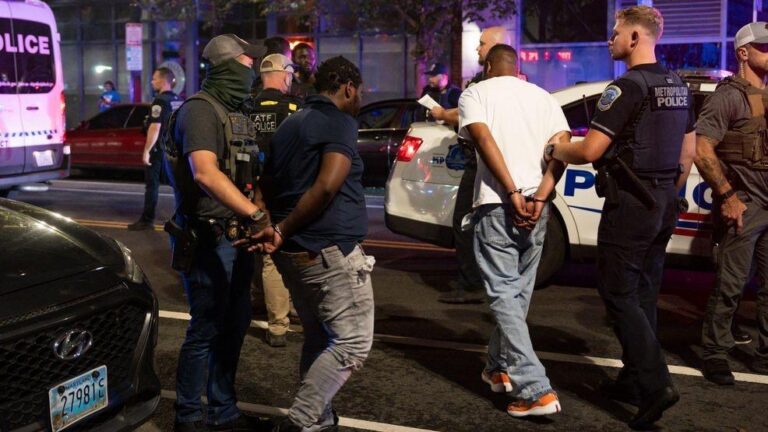Federal Investigation Targets Washington DC Police Over Alleged Crime Data Manipulation
Federal authorities have launched a comprehensive investigation into the Washington DC Metropolitan Police Department amid accusations that officers deliberately altered crime statistics to understate violent crime rates. The inquiry focuses on whether these modifications were part of a coordinated effort to project a misleadingly positive image of public safety. Prosecutors are collaborating with independent auditors and data experts to scrutinize reported figures on assaults, robberies, and homicides spanning the last three years, aiming to verify the authenticity of the department’s crime records.
Investigators are concentrating on several critical issues, including:
- Inconsistencies between official crime reports and victim testimonies
- Unauthorized alterations during or after initial data entry
- Systematic underreporting trends in specific police districts
- Consequences for resource distribution and community relations
| Crime Type | Official Reports 2020 | Adjusted Estimates 2020 | Percentage Increase |
|---|---|---|---|
| Assault | 3,200 | 4,000 | +25% |
| Robbery | 1,100 | 1,450 | +32% |
| Homicide | 85 | 100 | +17.6% |
How Falsified Crime Data Undermines Public Trust and Policy Effectiveness
Allegations of manipulated crime figures severely damage community confidence in law enforcement agencies. When crime data is perceived as a tool for image management rather than an accurate reflection of reality, public skepticism grows. This distrust hampers collaborative policing efforts and may discourage victims and witnesses from coming forward, fearing their experiences will be minimized or misrepresented. Moreover, advocacy groups and community organizations depend on reliable crime data to advocate for reforms and allocate resources effectively; inaccurate statistics weaken their ability to hold authorities accountable.
Policy makers also face significant obstacles when crime data integrity is compromised. Accurate statistics are essential for informed decisions on budgeting, lawmaking, and program development. Distorted data can lead to misallocated funds and ineffective crime prevention strategies. The table below highlights potential policy repercussions stemming from inaccurate crime reporting:
| Policy Domain | Possible Consequences |
|---|---|
| Funding Distribution | Misguided allocation weakening frontline law enforcement |
| Legislative Measures | Ineffective or misdirected crime prevention laws |
| Community Initiatives | Reduced support or cancellation of essential programs |
Restoring public confidence and ensuring transparent governance necessitates stringent independent reviews and comprehensive reforms in crime data reporting. As the federal investigation progresses, demands for openness and accountability will intensify, compelling law enforcement leaders to maintain clear communication and foster trust with both the public and oversight entities.
In-Depth Review of Crime Data Management Within the Metropolitan Police Department
The Metropolitan Police Department’s procedures for handling crime data are under rigorous examination following federal allegations of statistical manipulation. Preliminary insights reveal that inconsistencies stem from improper classification of offenses and unauthorized adjustments aimed at reducing reported crime figures. Insider reports suggest tactics such as downgrading serious offenses to lesser categories and postponing incident entries to artificially improve crime statistics.
Experts analyzing internal audits have identified significant transparency and accountability deficiencies, raising doubts about the reliability of published crime data. The investigation is focusing on:
- Protocols for data entry and validation
- Supervisory controls over crime report modifications
- Influence of leadership pressures on statistical reporting
| Area | Identified Problem | Potential Consequence |
|---|---|---|
| Crime Reclassification | Reducing violent crimes to minor offenses | Underestimation of crime severity |
| Delayed Reporting | Postponed entry of daily crime data | Distorted monthly crime trends |
| Leadership Pressure | Encouragement to alter data to meet targets | Compromised data credibility |
Strategies to Improve Transparency and Accountability in Crime Data Reporting
Implementing clear guidelines and independent oversight is essential for trustworthy crime reporting systems. Standardizing data collection and verification procedures ensures consistency and accuracy across all police districts. Furthermore, regular audits by external agencies or federal bodies can detect discrepancies or intentional falsifications before they affect public perception or policy formulation.
To bolster data integrity, law enforcement agencies should integrate advanced technology solutions that enable real-time data tracking and provide public access to crime statistics. Transparency can be further enhanced by publishing detailed methodologies and explanations for any data adjustments. The following table outlines critical components for effective crime reporting frameworks:
| Component | Objective | Advantage |
|---|---|---|
| Uniform Data Entry Standards | Guarantees consistent reporting practices | Reduces errors and prevents manipulation |
| Periodic External Audits | Confirms data accuracy and integrity | Enhances public confidence and accountability |
| Open Access Dashboards | Provides real-time transparency | Encourages community involvement and oversight |
| Defined Penalties for Misreporting | Ensures accountability for data falsification | Deters future misconduct |
Conclusion: Reflecting on the Federal Probe and Its Broader Implications
As the federal investigation into the Washington DC Metropolitan Police Department advances, scrutiny remains fixed on the accuracy of crime reporting and its wider impact on law enforcement accountability. This case highlights persistent challenges surrounding transparency and the indispensable role of reliable data in fostering public trust and guiding policy decisions. Stakeholders throughout the city and beyond are closely watching developments, anticipating outcomes that could reshape crime reporting standards and community relations in the years ahead.







